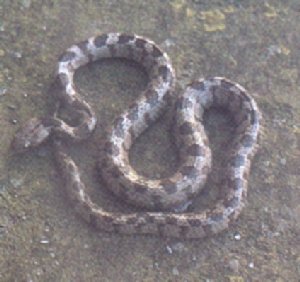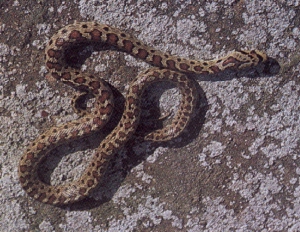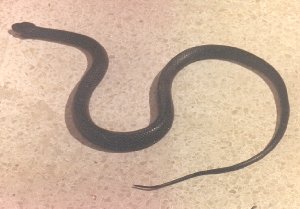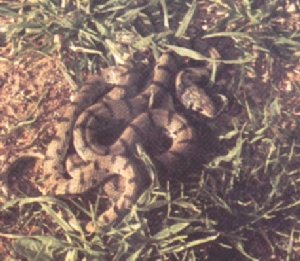SNAKES OF THE MALTESE ISLANDS
INTRODUCTION
Four species of snake are recorded from the Malta, two of which
are probably accidental introductions which have become naturalised.
IDENTIFICATION
KEY TO THE MALTESE SPECIES
1a. - Loreal shield borders the eye........................................................Telescopus
fallax fallax
1b. - loreal shield separated from the eye border by 1-2 preoccular
shields............................2
2a. - Scales across the middle of the body number less than 25 scales...........................................................................................................................................3
2b. - Scales across the middle of the body number 25-27.....................Elaphe
situla leopardina
3a. - Scales across the middle of the body number 23 or 25..............Coluber
florulentus algirus
3b. - Scales across the middle of the body number 17-21 usually
19..........Coluber viridiflavus carbonarius
SYSTEMIC IDENTIFICATION OF THE MALTESE OPHIDEA SPECIES
Class: REPTILIA
Order: SQUAMATA
Sub-order: OPHIDEA
Family: COLUBRIDAE
Telescopus fallax fallax (Flieschmann,
1831)
Cat Snake
maltese: Serp
Size: Up to just one metre long.
Colouration: Dorsally pale brown or greyish with dark brown
transverse spots and a lateral alternating series of brown transverse bars;
ventrally greyish white with fine grey specks.
Biology: This snake is a nocturnal hunter feeding on lizards,
geckos, other snakes and small mammals. After weakening its prey by coiling
itself round it, the snake then gives the coup de grace by the poison
fangs situated at the back of the mouth. The poison apparatus is primitive,
and the poison oly strong enough to affect small animals. The Cat Snake
lives in rocky habitats and dislikes extremes of temperature. Eggs are
laid in July.
Records: The first record of this snake from Malta dates
back to 1894 (Giglioli, 1894) when the species wasbelieved to be an introduced
exotic. Borg (1939) suggests that the Cat Snake was introduced to Floriana
during the First World war along with shipments of fire-wood, and then
gradually spread from there. Most records of this species have been from
the same general region of Floriana, Marsa and Paola, suggesting that Borg's
theory may be correct. However this species is shy and nocturnal, and it
is possible that its presence is more widespread then generally thought
and it may be originally indigenous. Even if introduced it appears to have
become natulised in the Southeastern part of Malta.
Elaphe situal leopardina (Bonaparte,
1834)
Leopard Snake
maltese: Lifgha
Size: Up to one metre long.
Colouration: Dorsally pale brown with dark brown or reddish
black-edged transverse spots and a forked black mark on the occiput and
nape; ventrally white checkered with black.
Biology: This is a common species, but is not frequently
encountered since it prefers dark and sheltered localities. It is common
in shaded valleys, often coiling itself around tree branches. It forages
for food at dawn and dusk, and feeds on young birds, lizards, geckos, frogs,
mice, small rats, and small snakes.
Records: This species is one of the indifgenous snakes of
the Maltese Islands, and has been recorded from Malta, Gozo and Comino.
It is possible that this species was the "viper" which bit the Apostle
paul on his arrival in Malta.
Coluber viridiflavus carbonarius (Bonaparte,
1833)
Black Whip Snake
maltese: Serp iswed
Size: Up to two metres long.
Colouration: Dorsally the adult is black but juveniles are
a dark green marked with grey and dark brown; ventraklly white to yellowish
white. The different colouration at different ages has led some previous
naturalists to think that this species was represented in the Maltese Islands
by two subspecies - carbonarius and the nominative - viridiflavus.
Biology: This snake is very lively and often climbs trees
in search of food. It hunts around mid-day and feeds on lizards, skinks,
geckos, rats, mice, frogs, and the young and eggs of ground or tree-nesting
birds. The Whip Snake lives in rock cracks and under rubble. When cornered
it strikes and bites furiously. The animal hibernates during the winter
months.
Records: A very widespread species recorded from Malta, Gozo
and Comino.
Coluber florulentus algirus (Jan, 1833)
Algerian Whip Snake
maltese: Serp Algerin
Size: Up to one metre long.
Colouration: Dorsally pale ochre or grey with transverse
black bars at intervals and a black spot below the eye; ventrally white.
Biology: This species lives in cracks in rocks and fortifications.
It is active at sunset and feeds on lizards, skinks, geckos, small snakes,
young birds and small mammals.
Records: This species is very limited in distribution being
found only in the southeastern part of Malta. Borg (1939) suggests that
this species has been intyroduced during the First World War along with
fire-wood shipments stored at Floriana.
 References
References




